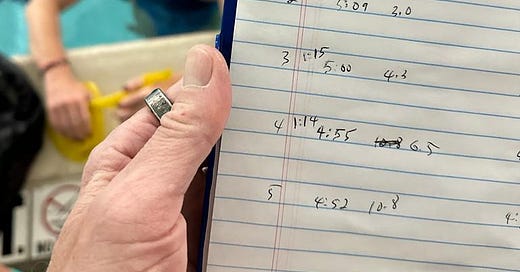We had the opportunity to get a pace vs lactate profile for Coach Monsy. Although she’s faster than most people reading this article… her profile will be quite similar.
So I’m going to use her as a case study for how you can measure, then improve, your swim profile.
The Test Set
The 5x400 Test Set comes from my article Benchmarking Your Swim. Typically, the test set is swum on not more than 15 seconds rest (per interval). However, that’s not enough time to test lactate so the rest interval was increased to 30 seconds.
The instructions were simple…
Start easy, and swim each one faster than the previous one.
Guidance of “low 1:20s” pace was given to start.

Examining The Profile
What do you notice about Monica’s profile?
She’s fit. It’s no wonder she can comfortably swim off a 1:20 LCM1 send off.
Her lactate is up at what feels like Easy Pace. Note this is a single test and there can be a range of reasons of elevated early lactate.
When pace-per-100-meters is converted to meters-per-second, it is clear that she doesn’t speed up much.
Points 2 & 3 are relevant to most every swimmer I work with.
Subjectively Scored Easy Pace can have more internal stress than we realize. We see this most commonly with swimming and running.
Many swimmers have a relatively tight pace range. We see this in all sports with athletes gravitating to a Moderately-Hard / Zone 3 effort for their endurance training, most particularly for sessions of 45 to 90 minutes duration.
Further Information
For Monica, and you (if you have this profile), there is additional information required:
How slow can Monica swim and maintain excellent mechanics? More of an issue for less experienced swimmers. Slow swimmers may need a combination of short intervals, flotation and fins to train in their Green Zone (Easy / Steady).
What is the pace required to bottom out lactate? In many cases, the swimmer doesn’t have Easy Pace available to them. Because of Monica’s background, we know she does. What we don’t know is the speed that corresponds to this intensity.
How good are her stroke mechanics? Underwater video analysis, shared with the swimmer, can be an effective way to review. Are mechanics changing at high-intensity, increasing drag and/or reducing effective propulsion?
How does her specific strength compare to other swimmers with her profile? Female, over 40, strong kick… there could be low hanging fruit by improving upper-body force production, both generally and specifically.
What happens to her profile if we give her more rest? Another test set is 7x200 descending 1 to 7 leaving on a total time of 5 minutes (including the previous swim). What happens to velocity when additional rest is added?
Does the work, and the resulting profile, match the athlete’s goals for the up-coming year? If you follow me on Twitter then you will have seen many of Monica’s favorite swim sets. From those sets, you know how she trains her key workouts. When you’re working with yourself, or another athlete, the athlete’s recent training history is relevant to assessing their profile. In Monica’s case, she does a lot of work using a 1:20 meters send off. As a result… she’s optimized for that type of swimming.
Training Modifications
Monica’s coach is Julie Dibens and I’m looking forward to learning from them as they work together.
Julie is an expert at making people who are already fast… faster.
That’s not easy.
I have more experience working with athletes who aren’t swimming at a front-pack triathlon level. Interestingly, they have a profile very similar to Monica’s, just slower.
Here’s what we do:
Ensure at least half the weekly swim volume is internally Easy Pace. Not it-feels-easy-coach… truly easy.
Make the key Green Zone swim 90 minutes duration, of swimming. For a 3x a week swimmer, this one change can have dramatic results.
Use the bike to improve metabolic fitness. My Metabolic Manifesto is not just for Runners and Multisport athletes.
Capture underwater video, across the athlete’s entire pace profile. Get as much power converted to forward propulsion as possible. Often times, mechanics change as intensity increases. See if there is a technical breakpoint in stroke mechanics under duress. Shorter interval durations, at pace, can help build stroke endurance.
Challenge stroke mechanics. Using a snorkel, off-side breathing, 3-stroke and 5-stroke breathing… changing long-held patterns can assist with improving stroke mechanics.
Consider what’s “not there” in the program. Topics such as: gym strength, in-sport strength, mobility, nutrition, and off-days.
What does the athlete prefer to do? Be willing to work against preference, but not so much the athlete loses their joy of swimming.
Every athlete has a limit of what’s possible in terms of change and additional commitment.
My advice:
Consider Everything.
Pick One Thing.
Make It A Habit.
Repeat.
Back to Table of Contents
LCM = Long Course Meters (50m per length), SCM = Short Course Meters (25m per length), SCY = Short Course Yards (25 yards per length).






Agreed. Think we are saying the same thing. Didn’t realize she was in a group. Peer pressure!
Gordo - would you say she started off ez enough ? Wouldn’t 2.3 L read out already be above LT1 (assuming Lt1 is 1.5 ish). My conclusion from the data - which is great btw - is she needs to develop her z1 / z2 and probably needs some over dx in the 1’25/m range.